Assessing the Environmental Performances of Nature-Based Solutions Implementation in Urban Environments through Visible and Near-Infrared Spectroscopy: A Combined Approach of Proximal and Remote Sensing for Monitoring and Evaluation
Abstract
:1. Introduction
1.1. Nature-Based Solutions Overview
1.2. Monitoring and Evaluation of NbS Implementation
1.3. UPPER Project—Urban Productive Parks for the Development of NbS Related Technologies and Services
2. Materials and Methods
2.1. Territorial Context of the Monitored Areas
2.2. Proximal Sensing Monitoring
2.2.1. The Proximal Sensing Device: Portable NIR Spectrometer
2.2.2. Analyzed Samples, Spectra Collection and Handling
2.2.3. Proximal Sensing Indices Computing
2.3. Remote Sensing Monitoring
2.3.1. The Sentinel-2 L2A Satellite
- (i)
- 10 m spatial resolution (B2 (490 nm), B3 (560 nm), B4 (665 nm) and B8 (842 nm));
- (ii)
- 20 m spatial resolution (B5 (705 nm), B6 (740 nm), B7 (783 nm), B8a (865 nm), B11 [1610 nm] and B12 [2190 nm]);
- (iii)
- 60 m spatial resolution (B1 (443 nm), B9 (940 nm) and B10 (1375 nm)).
2.3.2. Satellite Data Analysis and Remote Sensing-Derived Indices
2.4. Meteo-Climatic Monitoring
2.5. Exploratory, Statistical Data, and Multivariate Regression Analyses
3. Results and Discussion
3.1. In-Field Proximal Sensing Indices Ex Ante NbS Interventions
3.2. Remote Sensing Index Variations
3.2.1. Variation in NDVI Values (2022–2023)
3.2.2. Variation in NDWI Values (2022–2023)
3.2.3. Considerations about NDVI and NDWI Variations (2022–2023)
3.2.4. Considerations about NDVI and NDWI Variations (Baseline 2015–2022 and 2023)
3.3. Meteorological and Hydroclimate Data Analysis
3.4. Correlation Analysis and PLS Regression Results
4. Conclusions
Supplementary Materials
Author Contributions
Funding
Institutional Review Board Statement
Informed Consent Statement
Data Availability Statement
Conflicts of Interest
References
- Cohen-Shacham, E.; Walters, G.; Janzen, C.; Maginnis, S. Nature-Based Solutions to Address Global Societal Challenges; IUCN: Gland, Switzerland, 2016; Volume 97, pp. 2016–2036. [Google Scholar]
- Sheikholeslami, D.; Murti, R. Nature-Based Recovery Initiative Nature-Based Solutions for Recovery-Opportunities, Policies and Measures; IUCN: Gland, Switzerland, 2021. [Google Scholar]
- Bauduceau, N.; Berry, P.; Cecchi, C.; Elmqvist, T.; Fernandez, M.; Hartig, T.; Krull, W.; Mayerhofer, E.; Sandra, N.; Noring, L. Towards an EU Research and Innovation Policy Agenda for Nature-Based Solutions & Re-Naturing Cities: Final Report of the Horizon 2020 Expert Group on ‘Nature-Based Solutions and Re-Naturing Cities’; Publications Office of the European Union: Luxembourg, 2015. [Google Scholar]
- IUCN. Global standard for nature-based solutions. A user-friendly framework for the verification, design and scaling up of NbS. Accessed 2020, 15, 2022. [Google Scholar]
- Dumitru, A.; Wendling, L. Evaluating the Impact of Nature-Based Solutions: A Handbook for Practitioners; European Commission EC: Luxembourg, 2021.
- Sowińska-Świerkosz, B.; García, J. What are Nature-based solutions (NBS)? Setting core ideas for concept clarification. Nat. Based Solut. 2022, 2, 100009. [Google Scholar] [CrossRef]
- Benedict, M.A.; McMahon, E.T. Green Infrastructure: Linking Landscapes and Communities; Island Press: Washington, DC, USA, 2012. [Google Scholar]
- Bourguignon, D. Nature-Based Solutions Concept, Opportunities and Challenges; European Parliamentary Research Service, EPRS: Brussels, Belgium, 2017. [Google Scholar]
- European Commission. Science for Environment Policy. The solution is in nature. In Brief Produced for the European Commission DG Environment; Science Communication Unit, UWE Bristol: Bristol, UK, 2021. [Google Scholar]
- Eggermont, H.; Balian, E.; Azevedo, J.M.N.; Beumer, V.; Brodin, T.; Claudet, J.; Fady, B.; Grube, M.; Keune, H.; Lamarque, P. Nature-based solutions: New influence for environmental management and research in Europe. GAIA-Ecol. Perspect. Sci. Soc. 2015, 24, 243–248. [Google Scholar] [CrossRef]
- Scott, M.; Lennon, M.; Haase, D.; Kazmierczak, A.; Clabby, G.; Beatley, T. Nature-based solutions for the contemporary city/Re-naturing the city/Reflections on urban landscapes, ecosystems services and nature-based solutions in cities/Multifunctional green infrastructure and climate change adaptation: Brownfield greening as an adaptation strategy for vulnerable communities?/Delivering green infrastructure through planning: Insights from practice in Fingal, Ireland/Planning for biophilic cities: From theory to practice. Plan. Theory Pract. 2016, 17, 267–300. [Google Scholar]
- Chrysoulakis, N.; Somarakis, G.; Stagakis, S.; Mitraka, Z.; Wong, M.-S.; Ho, H.-C. Monitoring and Evaluating Nature-Based Solutions Implementation in Urban Areas by Means of Earth Observation. Remote Sens. 2021, 13, 1503. [Google Scholar] [CrossRef]
- Liquete, C.; Udias, A.; Conte, G.; Grizzetti, B.; Masi, F. Integrated valuation of a nature-based solution for water pollution control. Highlighting hidden benefits. Ecosyst. Serv. 2016, 22, 392–401. [Google Scholar] [CrossRef]
- Van den Bosch, M.; Sang, Å.O. Urban natural environments as nature-based solutions for improved public health–A systematic review of reviews. Environ. Res. 2017, 158, 373–384. [Google Scholar] [CrossRef] [PubMed]
- Raymond, C.M.; Frantzeskaki, N.; Kabisch, N.; Berry, P.; Breil, M.; Nita, M.R.; Geneletti, D.; Calfapietra, C. A framework for assessing and implementing the co-benefits of nature-based solutions in urban areas. Environ. Sci. Policy 2017, 77, 15–24. [Google Scholar] [CrossRef]
- Augusto, B.; Roebeling, P.; Rafael, S.; Ferreira, J.; Ascenso, A.; Bodilis, C. Short and medium-to long-term impacts of nature-based solutions on urban heat. Sustain. Cities Soc. 2020, 57, 102122. [Google Scholar] [CrossRef]
- Kabisch, N.; Frantzeskaki, N.; Pauleit, S.; Naumann, S.; Davis, M.; Artmann, M.; Haase, D.; Knapp, S.; Korn, H.; Stadler, J. Nature-based solutions to climate change mitigation and adaptation in urban areas: Perspectives on indicators, knowledge gaps, barriers, and opportunities for action. Ecol. Soc. 2016, 21, 39. [Google Scholar] [CrossRef]
- Ruangpan, L.; Vojinovic, Z.; Di Sabatino, S.; Leo, L.S.; Capobianco, V.; Oen, A.M.; McClain, M.E.; Lopez-Gunn, E. Nature-based solutions for hydro-meteorological risk reduction: A state-of-the-art review of the research area. Nat. Hazards Earth Syst. Sci. 2020, 20, 243–270. [Google Scholar] [CrossRef]
- Ahern, J. From fail-safe to safe-to-fail: Sustainability and resilience in the new urban world. Landsc. Urban Plan. 2011, 100, 341–343. [Google Scholar] [CrossRef]
- Calliari, E.; Staccione, A.; Mysiak, J. An assessment framework for climate-proof nature-based solutions. Sci. Total Environ. 2019, 656, 691–700. [Google Scholar] [CrossRef] [PubMed]
- Palomo, I.; Felipe-Lucia, M.R.; Bennett, E.M.; Martín-López, B.; Pascual, U. Disentangling the pathways and effects of ecosystem service co-production. In Advances in Ecological Research; Elsevier: Amsterdam, The Netherlands, 2016; pp. 245–283. [Google Scholar]
- Plieninger, T.; Bieling, C.; Fagerholm, N.; Byg, A.; Hartel, T.; Hurley, P.; López-Santiago, C.A.; Nagabhatla, N.; Oteros-Rozas, E.; Raymond, C.M. The role of cultural ecosystem services in landscape management and planning. Curr. Opin. Environ. Sustain. 2015, 14, 28–33. [Google Scholar] [CrossRef]
- Elmasry, G.; Kamruzzaman, M.; Sun, D.-W.; Allen, P. Principles and Applications of Hyperspectral Imaging in Quality Evaluation of Agro-Food Products: A Review. Crit. Rev. Food Sci. Nutr. 2012, 52, 999–1023. [Google Scholar] [CrossRef] [PubMed]
- Bonifazi, G.; Gasbarrone, R.; Serranti, S. Dried Red Chili Peppers Pungency Assessment by Visible and Near Infrared Spectroscopy; SPIE Defense + Commercial Sensing: National Harbor, Maryland, 2019; Volume 10986. [Google Scholar]
- Cortés, V.; Blasco, J.; Aleixos, N.; Cubero, S.; Talens, P. Monitoring strategies for quality control of agricultural products using visible and near-infrared spectroscopy: A review. Trends Food Sci. Technol. 2019, 85, 138–148. [Google Scholar] [CrossRef]
- Bonifazi, G.; Gasbarrone, R.; Serranti, S. Detection of Olive Fruits Attacked by Olive Fruit Flies Using Visible-Short Wave Infrared Spectroscopy; SPIE OPTO: Washington, DC, USA, 2021; Volume 11693. [Google Scholar]
- Askari, M.S.; Cui, J.; O’Rourke, S.M.; Holden, N.M. Evaluation of soil structural quality using VIS–NIR spectra. Soil Tillage Res. 2015, 146, 108–117. [Google Scholar] [CrossRef]
- Rossel, R.V.; Cattle, S.R.; Ortega, A.; Fouad, Y. In situ measurements of soil colour, mineral composition and clay content by vis–NIR spectroscopy. Geoderma 2009, 150, 253–266. [Google Scholar] [CrossRef]
- Wan, M.; Qu, M.; Hu, W.; Li, W.; Zhang, C.; Cheng, H.; Huang, B. Estimation of soil pH using PXRF spectrometry and Vis-NIR spectroscopy for rapid environmental risk assessment of soil heavy metals. Process Saf. Environ. Prot. 2019, 132, 73–81. [Google Scholar] [CrossRef]
- Jones, H.G.; Vaughan, R.A. Remote Sensing of Vegetation: Principles, Techniques, and Applications; Oxford University Press: Oxford, UK, 2010. [Google Scholar]
- Xiang, P.; Yang, Y.; Li, Z. Theoretical framework of inclusive urban regeneration combining nature-based solutions with society-based solutions. J. Urban Plan. Dev. 2020, 146, 04020009. [Google Scholar] [CrossRef]
- Peñuelas, J.; Filella, I. Visible and near-infrared reflectance techniques for diagnosing plant physiological status. Trends Plant Sci. 1998, 3, 151–156. [Google Scholar] [CrossRef]
- Schlerf, M.; Atzberger, C.; Hill, J. Remote sensing of forest biophysical variables using HyMap imaging spectrometer data. Remote Sens. Environ. 2005, 95, 177–194. [Google Scholar] [CrossRef]
- Underwood, E.; Ustin, S.; DiPietro, D. Mapping nonnative plants using hyperspectral imagery. Remote Sens. Environ. 2003, 86, 150–161. [Google Scholar] [CrossRef]
- Galvao, L.S.; Formaggio, A.R.; Tisot, D.A. Discrimination of sugarcane varieties in Southeastern Brazil with EO-1 Hyperion data. Remote Sens. Environ. 2005, 94, 523–534. [Google Scholar] [CrossRef]
- Ustin, S.L.; Roberts, D.A.; Gardner, M.; Dennison, P. Evaluation of the potential of Hyperion data to estimate wildfire hazard in the Santa Ynez Front Range, Santa Barbara, California. In Proceedings of the IEEE International Geoscience and Remote Sensing Symposium, Toronto, ON, Canada, 24–28 June 2002. [Google Scholar]
- Curran, P.J. Remote sensing of foliar chemistry. Remote Sens. Environ. 1989, 30, 271–278. [Google Scholar] [CrossRef]
- European Space Agency. SENTINEL-2 MISSION GUIDE. Available online: https://sentinels.copernicus.eu/web/sentinel/missions/sentinel-2 (accessed on 7 November 2023).
- McFeeters, S.K. The use of the Normalized Difference Water Index (NDWI) in the delineation of open water features. Int. J. Remote Sens. 1996, 17, 1425–1432. [Google Scholar] [CrossRef]
- Zha, Y.; Gao, J.; Ni, S. Use of normalized difference built-up index in automatically mapping urban areas from TM imagery. Int. J. Remote Sens. 2003, 24, 583–594. [Google Scholar] [CrossRef]
- Ludescher, J.; Bunde, A.; Schellnhuber, H.J. Statistical significance of seasonal warming/cooling trends. Proc. Natl. Acad. Sci. USA 2017, 114, E2998–E3003. [Google Scholar] [CrossRef] [PubMed]
- Cammalleri, C.; Micale, F.; Vogt, J. On the value of combining different modelled soil moisture products for European drought monitoring. J. Hydrol. 2015, 525, 547–558. [Google Scholar] [CrossRef]
- Thielen, J.; Bartholmes, J.; Ramos, M.-H.; De Roo, A. The European flood alert system–part 1: Concept and development. Hydrol. Earth Syst. Sci. 2009, 13, 125–140. [Google Scholar] [CrossRef]
- Cammalleri, C.; Vogt, J.V.; Bisselink, B.; de Roo, A. Comparing soil moisture anomalies from multiple independent sources over different regions across the globe. Hydrol. Earth Syst. Sci. 2017, 21, 6329–6343. [Google Scholar] [CrossRef]
- McKee, T.B.; Doesken, N.J.; Kleist, J. The relationship of drought frequency and duration to time scales. In Proceedings of the 8th Conference on Applied Climatology, Anaheim, CA, USA, 17–22 January 1993. [Google Scholar]
- Bro, R.; Smilde, A.K. Principal component analysis. Anal. Methods 2014, 6, 2812–2831. [Google Scholar] [CrossRef]
- Montgomery, D.C.; Runger, G.C.; Hubele, N.F. Engineering Statistics; John Wiley & Sons: Hoboken, NJ, USA, 2009. [Google Scholar]
- Kendall, M.G. The Advanced Theory of Statistics, 2nd ed.; Charles Griffin and Co., Ltd.: London, UK, 1946. [Google Scholar]
- Wold, S.; Sjöström, M.; Eriksson, L. PLS-regression: A basic tool of chemometrics. Chemom. Intell. Lab. Syst. 2001, 58, 109–130. [Google Scholar] [CrossRef]
- Abdi, H. Partial least square regression (PLS regression). Encycl. Res. Methods Soc. Sci. 2003, 6, 792–795. [Google Scholar]
- Paprotny, D.; Morales-Nápoles, O.; Worm, D.T.H.; Ragno, E. BANSHEE–A MATLAB toolbox for Non-Parametric Bayesian Networks. SoftwareX 2020, 12, 100588. [Google Scholar] [CrossRef]


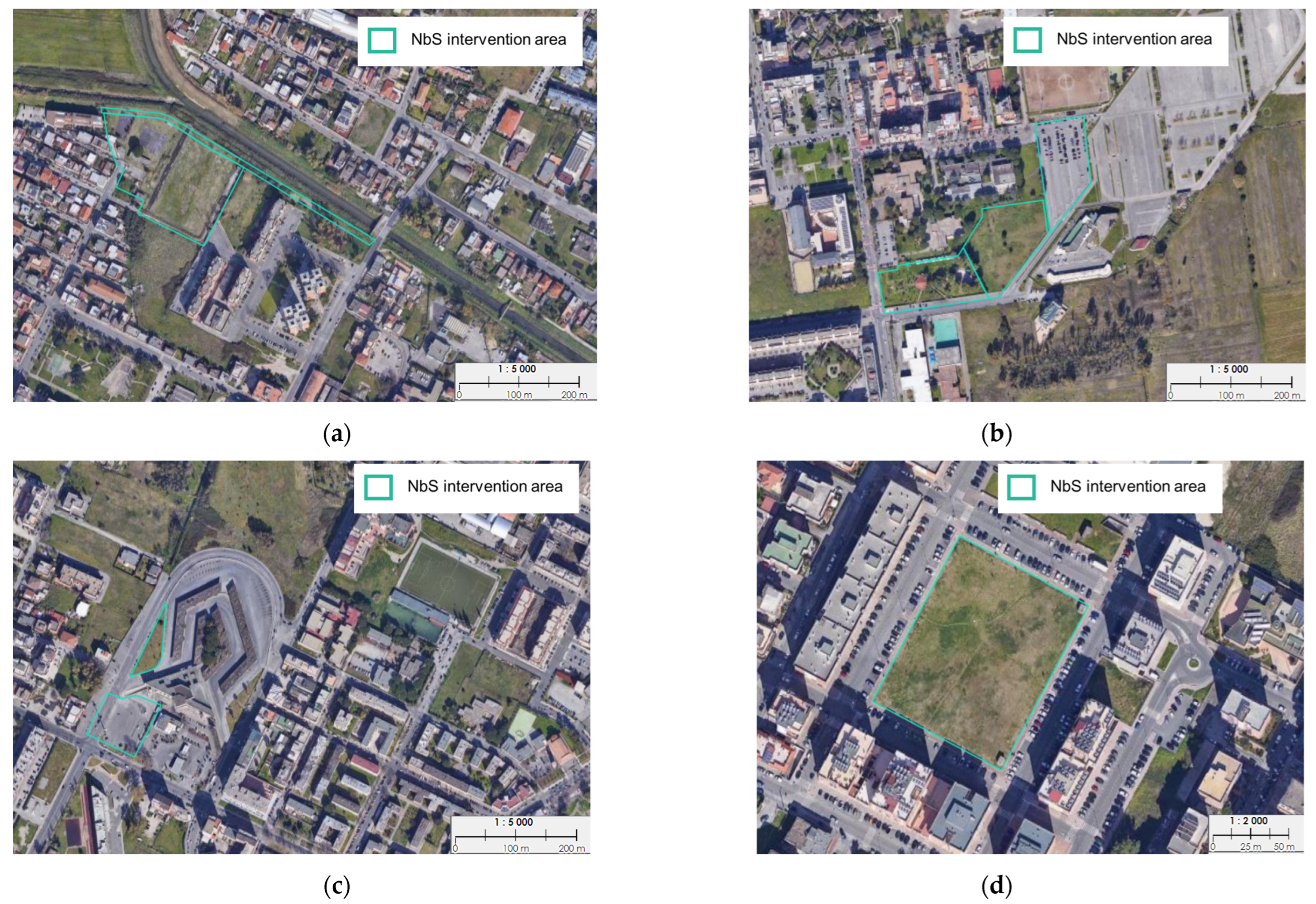

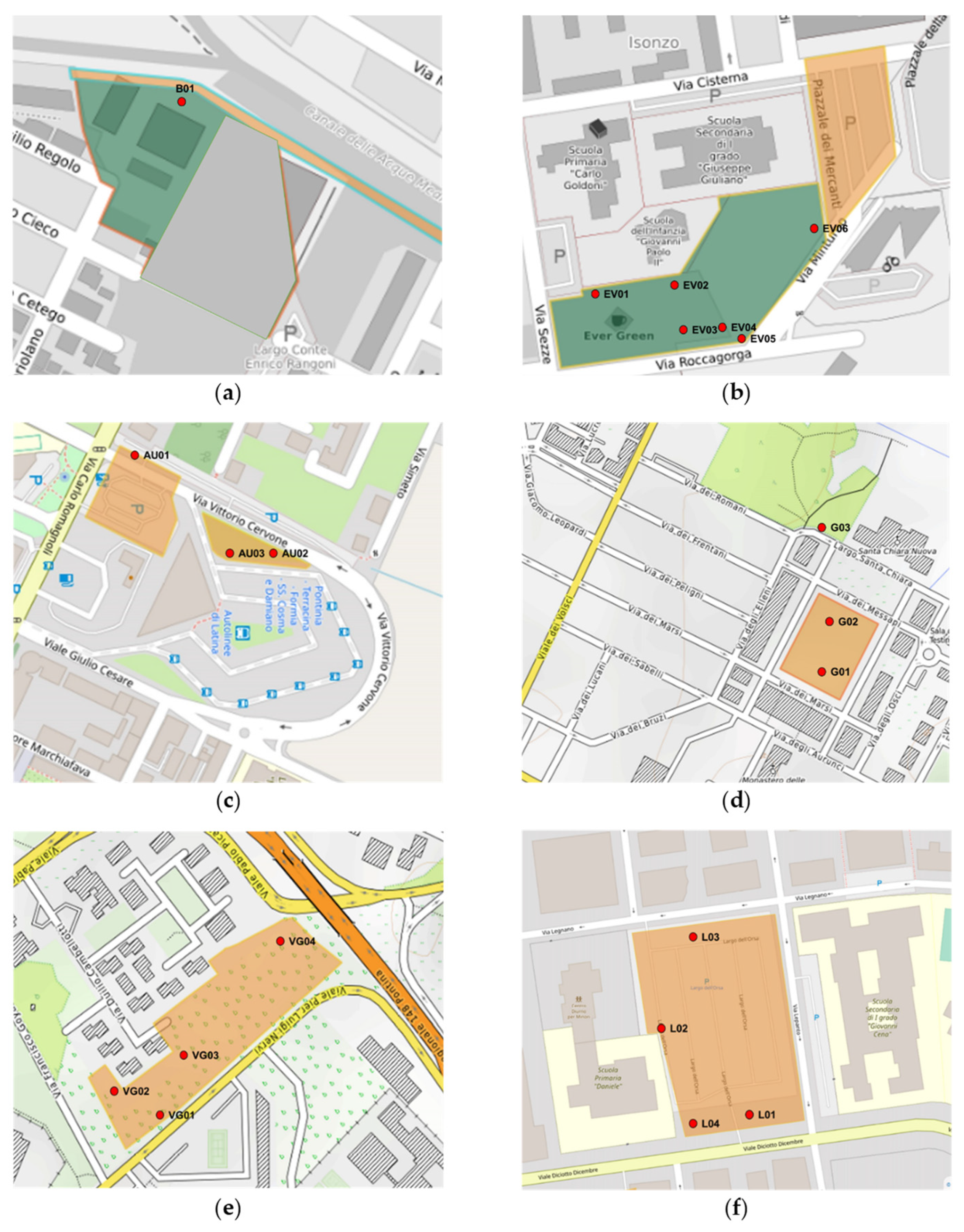


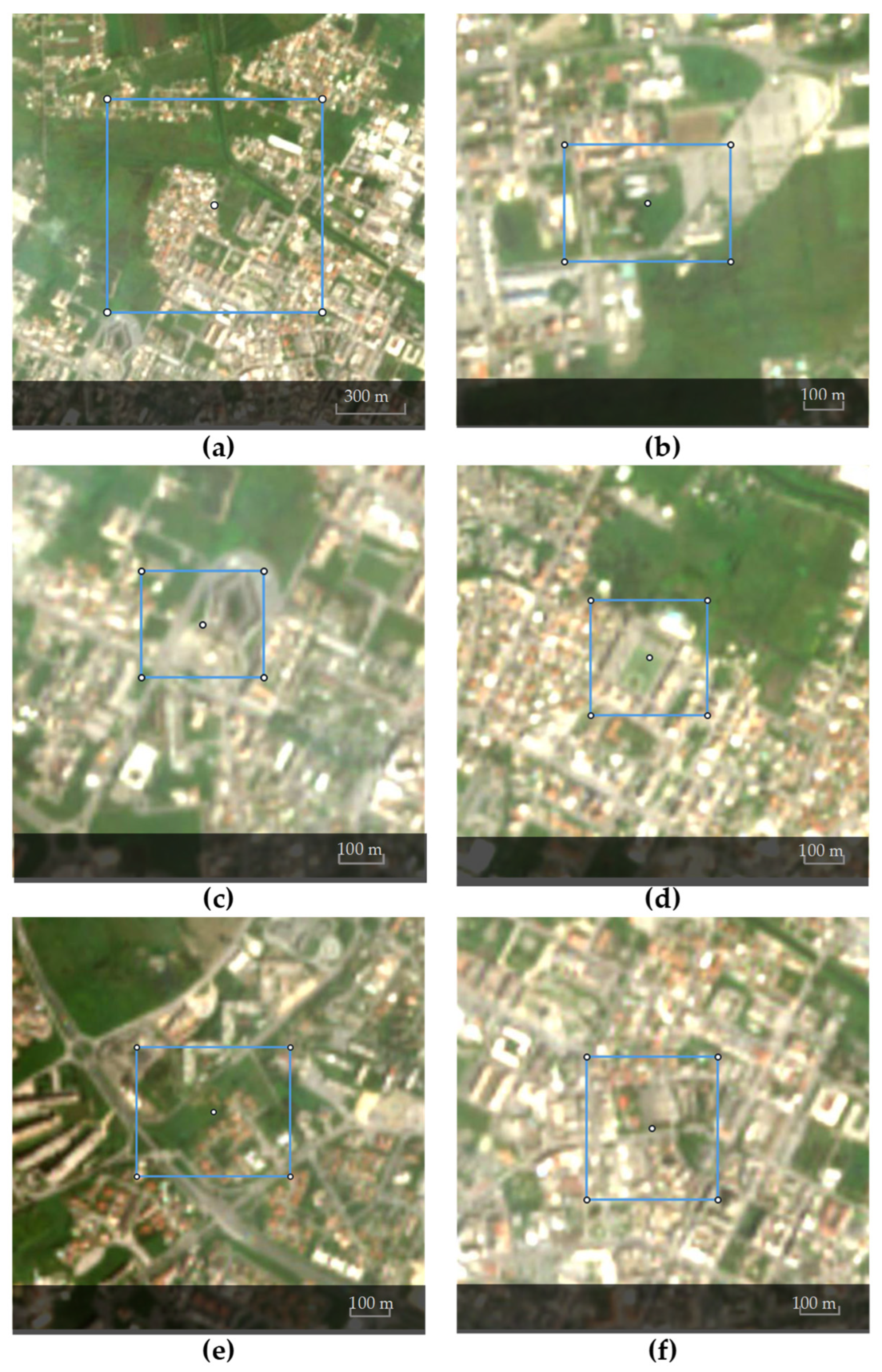

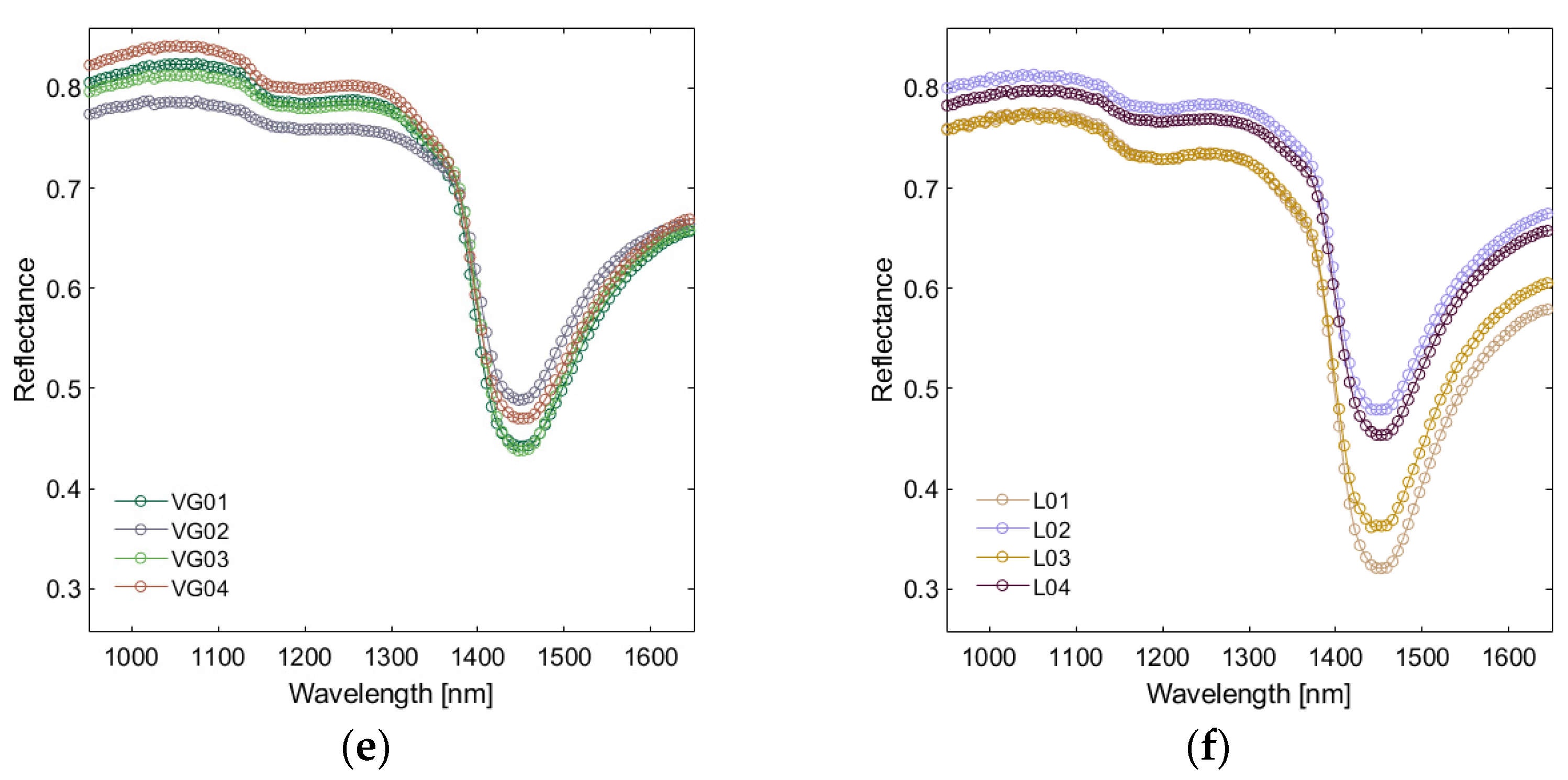

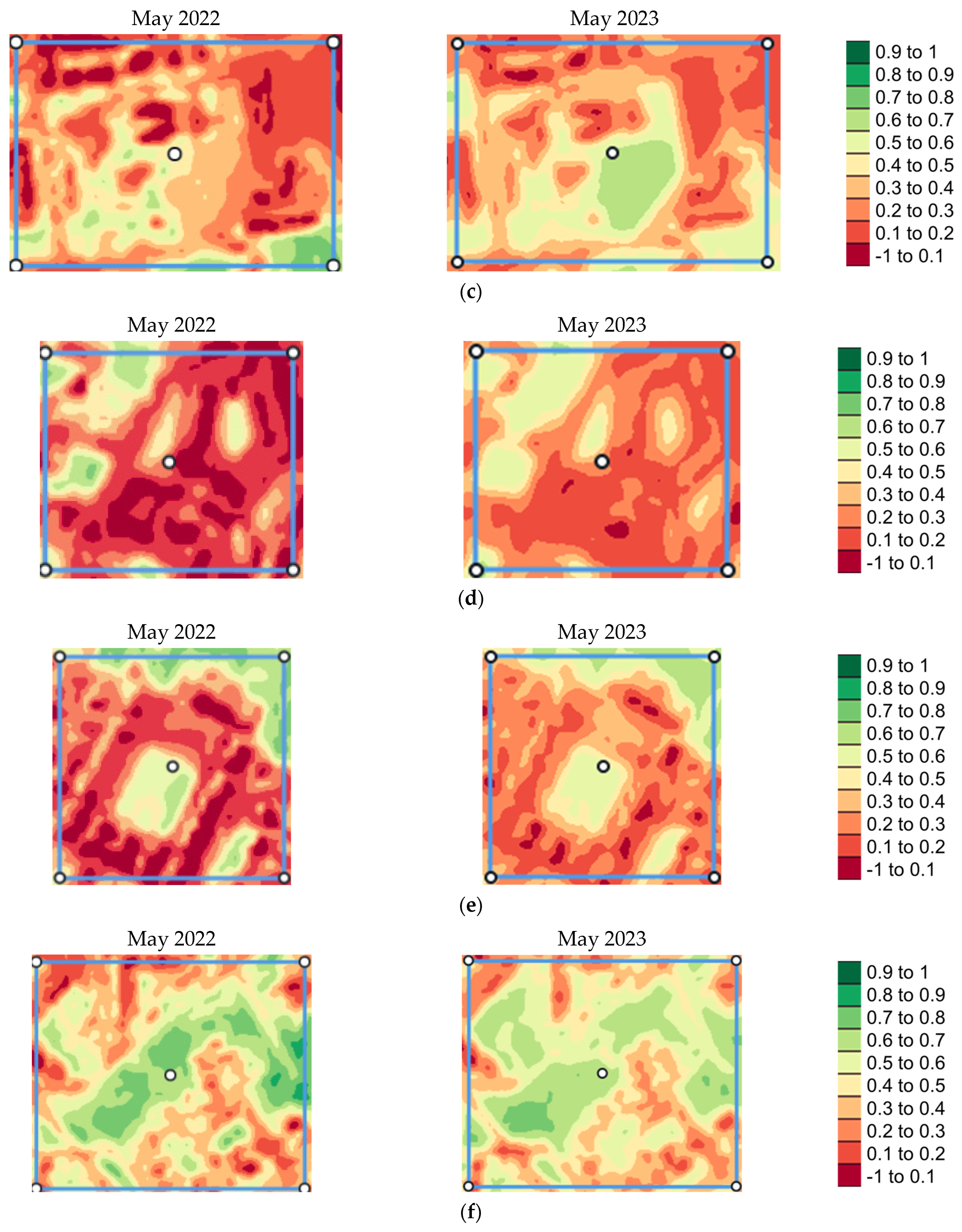
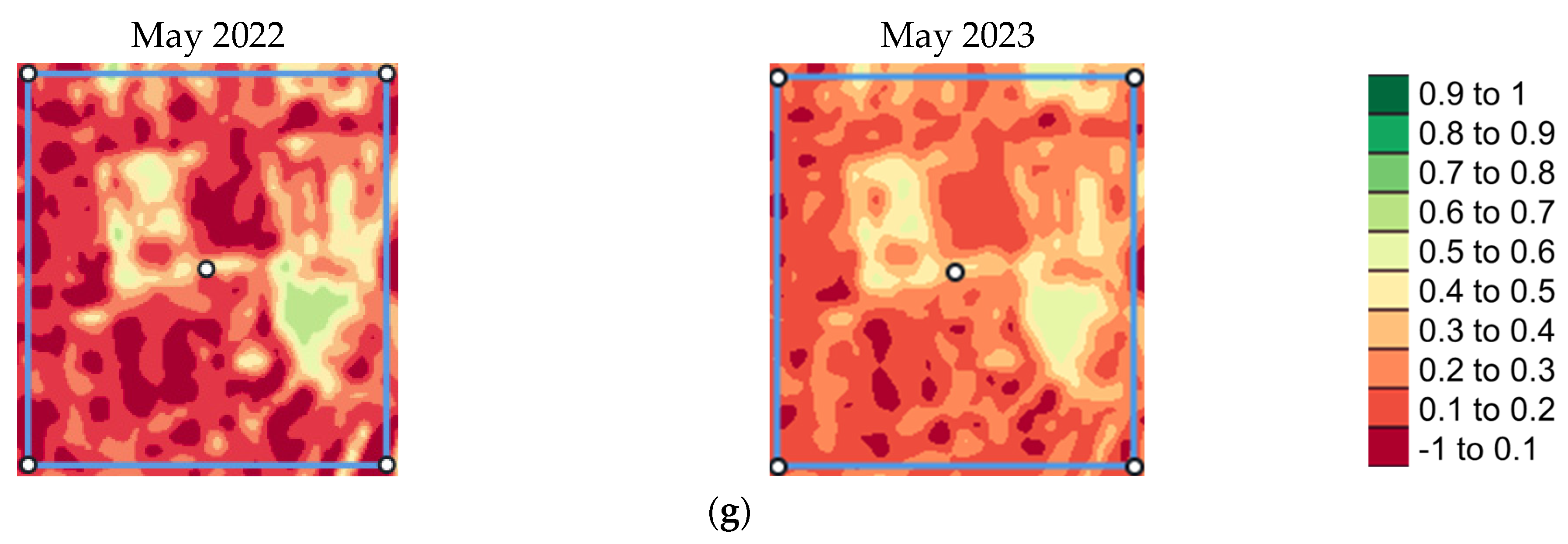
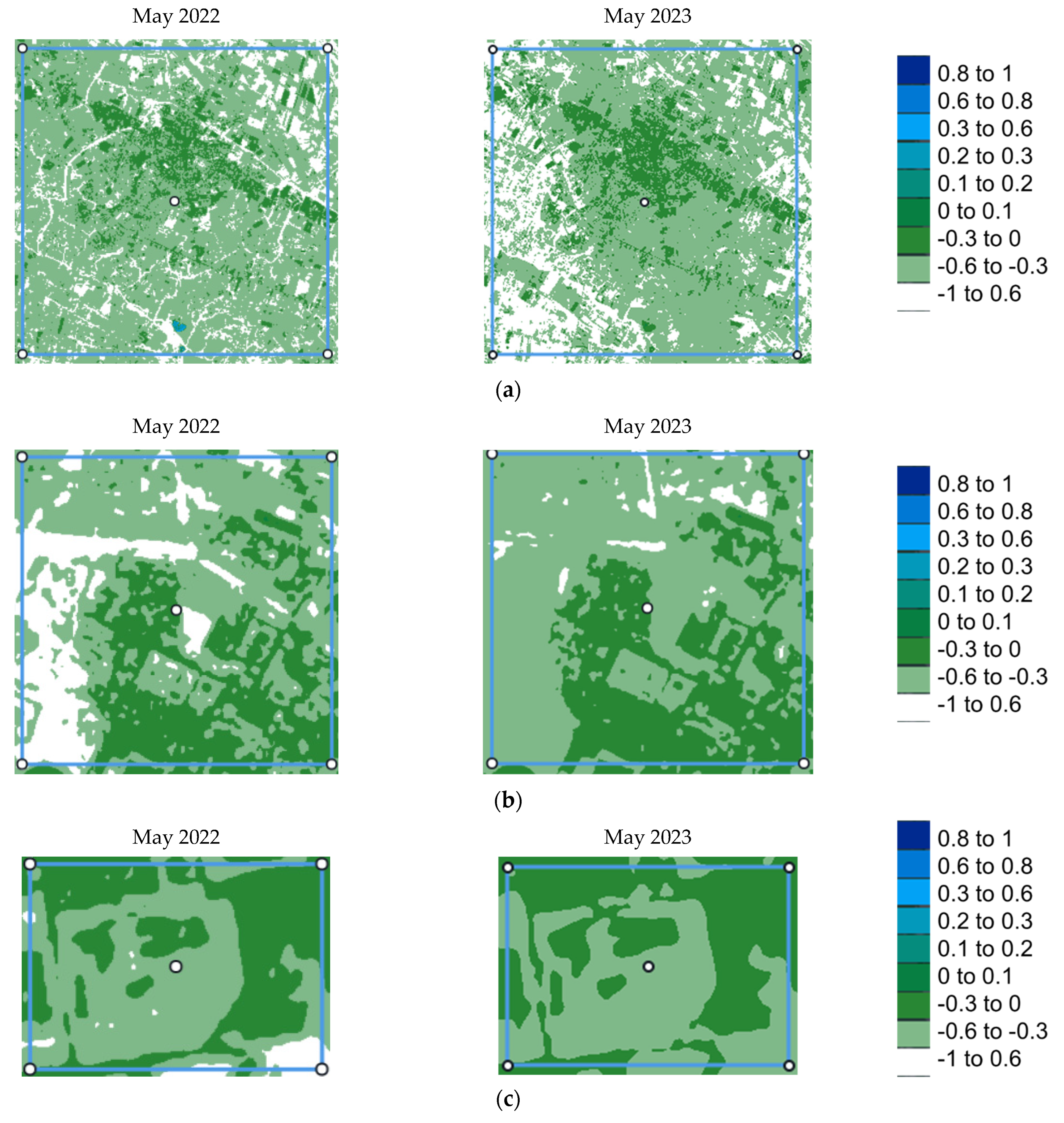
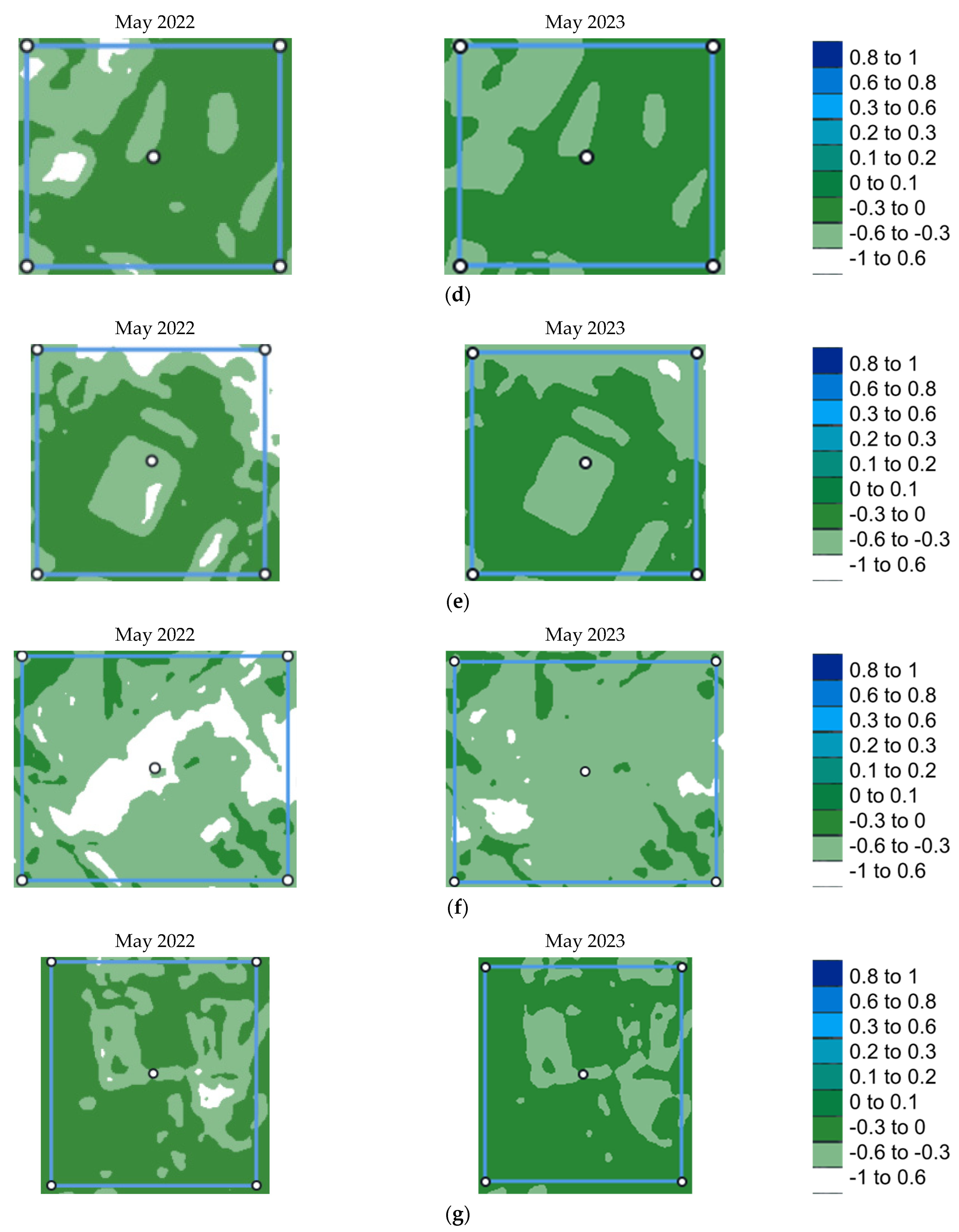






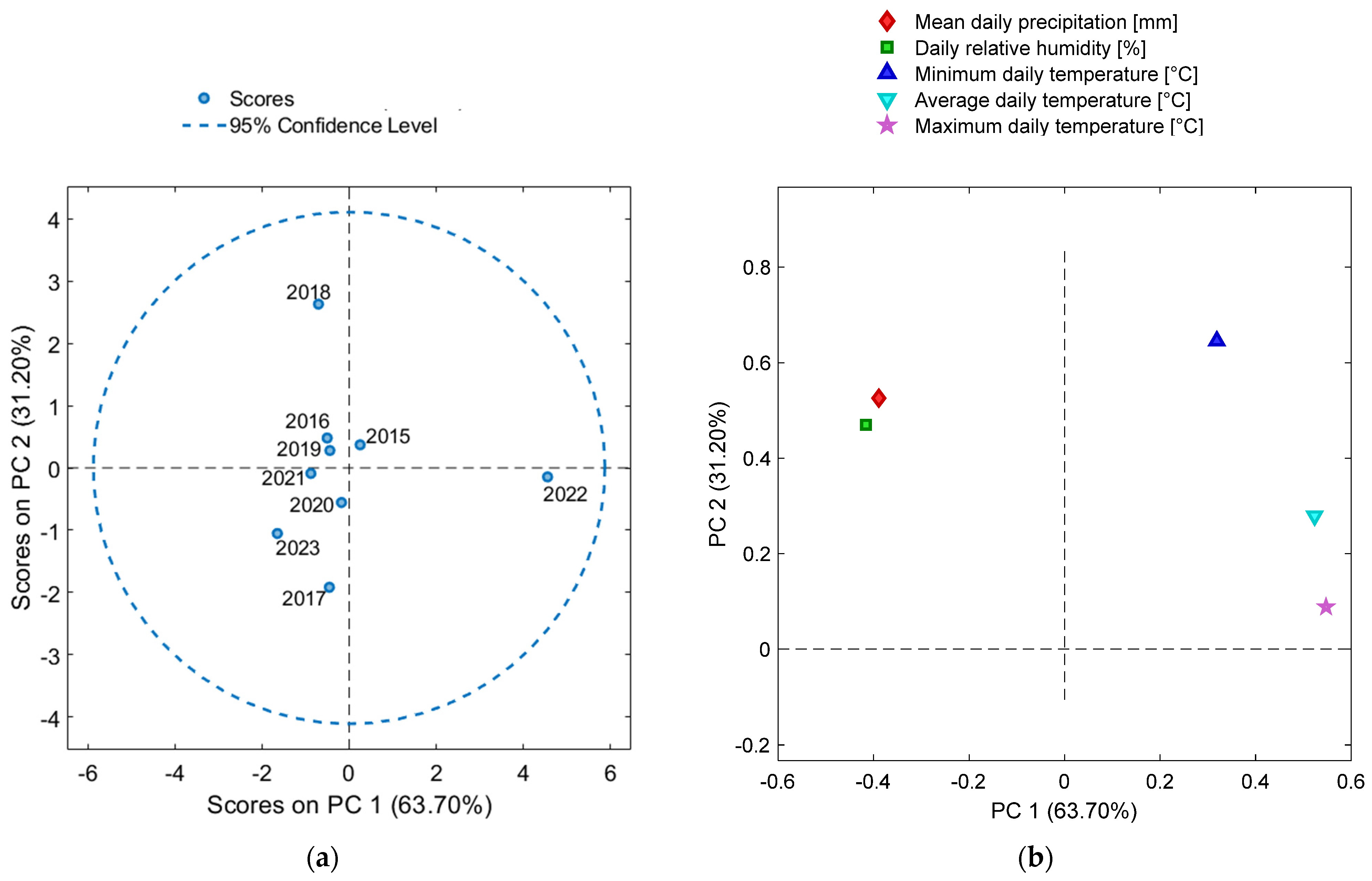



| UPPER Sites | Analyzed Plants |
|---|---|
| CAMPO BOARIO | B01—Junglans L. (walnut). |
| MERCATO | EV01—Laurus nobilis L. (laurel), EV02—Ulmus L. (elm), EV03—Quercus ilex L. (evergreen oak), EV04—Laurus nobilis L. (laurel), EV05—Celtis australis L. (honeyberry), EV06—Celtis australis L. (honeyberry). |
| AUTOLINEE | AU01—Eucalyptus obliqua L’Hér. (Tasmanian oak), AU02—Nerium oleander L. (oleander), AU03—Prunus spinosa L. (blackthorn). |
| PIAZZA ILARIA ALPI | G01—Quercus Cerris L. (Turkey oak), G02—Quercus ilex L. (evergreen oak), G03—Eucalyptus obliqua L’Hér. (Tasmanian oak). |
| VIA GOYA | VG01—Arundo donax L. (Arundo), VG02—Robinia pseudoacacia L. (black locust), VG03—Populus alba L. (white poplar), VG04—Arundo donax L. (giant cane). |
| VIA LEGNANO | L01—Eucalyptus obliqua L’Hér. (Tasmanian oak), L02—Laurus nobilis (laurel), L03—Eucalyptus obliqua L’Hér. (Tasmanian oak), L04—Ulmus minor Mill. (field elm). |
| Sample ID | Plants | LAIDI | RVIhyp | WC | LWVI2 | NDWIHyp | R970 nm | R1200 nm | R1250 nm | R1400 nm | R1450 nm |
|---|---|---|---|---|---|---|---|---|---|---|---|
| B01 | Walnut | 0.965 | 1.026 | 0.973 | 0.018 | 0.019 | 0.791 | 0.770 | 0.773 | 0.604 | 0.484 |
| EV01 | Laurel | 0.968 | 1.025 | 0.971 | 0.018 | 0.019 | 0.796 | 0.775 | 0.779 | 0.606 | 0.473 |
| EV02 | Elm | 0.969 | 1.024 | 0.974 | 0.016 | 0.018 | 0.791 | 0.772 | 0.775 | 0.605 | 0.481 |
| EV03 | Evergreen oak | 0.970 | 1.025 | 0.972 | 0.017 | 0.018 | 0.810 | 0.792 | 0.797 | 0.619 | 0.487 |
| EV04 | Laurel | 0.966 | 1.026 | 0.969 | 0.019 | 0.020 | 0.797 | 0.776 | 0.781 | 0.599 | 0.466 |
| EV05 | Honeyberry | 0.957 | 1.033 | 0.967 | 0.022 | 0.024 | 0.805 | 0.779 | 0.782 | 0.562 | 0.401 |
| EV06 | Honeyberry | 0.956 | 1.033 | 0.964 | 0.023 | 0.024 | 0.788 | 0.761 | 0.766 | 0.530 | 0.373 |
| AU01 | Tasmanian oak | 0.955 | 1.035 | 0.960 | 0.025 | 0.026 | 0.773 | 0.744 | 0.750 | 0.508 | 0.339 |
| AU02 | Oleander | 0.945 | 1.046 | 0.944 | 0.034 | 0.035 | 0.816 | 0.780 | 0.790 | 0.478 | 0.288 |
| AU03 | Blackthorn | 0.964 | 1.026 | 0.971 | 0.018 | 0.020 | 0.768 | 0.747 | 0.750 | 0.577 | 0.440 |
| G01 | Turkey oak | 0.976 | 1.017 | 0.983 | 0.012 | 0.013 | 0.741 | 0.727 | 0.730 | 0.629 | 0.546 |
| G02 | Evergreen oak | 0.962 | 1.026 | 0.969 | 0.020 | 0.021 | 0.790 | 0.764 | 0.769 | 0.586 | 0.441 |
| G03 | Tasmanian oak | 0.952 | 1.038 | 0.958 | 0.026 | 0.028 | 0.746 | 0.715 | 0.721 | 0.489 | 0.338 |
| VG01 | Arundo | 0.956 | 1.035 | 0.963 | 0.023 | 0.024 | 0.810 | 0.784 | 0.787 | 0.558 | 0.442 |
| VG02 | Black locust | 0.966 | 1.025 | 0.976 | 0.016 | 0.017 | 0.779 | 0.758 | 0.759 | 0.605 | 0.489 |
| VG03 | White poplar | 0.963 | 1.028 | 0.970 | 0.019 | 0.021 | 0.802 | 0.779 | 0.783 | 0.587 | 0.438 |
| VG04 | Arundo | 0.953 | 1.040 | 0.965 | 0.024 | 0.026 | 0.828 | 0.799 | 0.802 | 0.579 | 0.470 |
| L01 | Tasmanian oak | 0.948 | 1.039 | 0.955 | 0.028 | 0.030 | 0.764 | 0.729 | 0.735 | 0.490 | 0.321 |
| L02 | Laurel | 0.963 | 1.026 | 0.970 | 0.020 | 0.020 | 0.804 | 0.779 | 0.783 | 0.606 | 0.479 |
| L03 | Tasmanian oak | 0.948 | 1.037 | 0.961 | 0.026 | 0.028 | 0.763 | 0.729 | 0.734 | 0.505 | 0.363 |
| L04 | Field elm | 0.964 | 1.027 | 0.972 | 0.018 | 0.020 | 0.788 | 0.766 | 0.769 | 0.588 | 0.454 |
 | |||||||||||
| UPPER Site | LAIDI | RVIhyp | WC | LWVI2 | NDWIHyp |
|---|---|---|---|---|---|
| CAMPO BOARIO | 0.965 | 1.026 | 0.973 | 0.018 | 0.019 |
| MERCATO | 0.964 | 1.028 | 0.970 | 0.019 | 0.020 |
| AUTOLINEE | 0.955 | 1.036 | 0.958 | 0.026 | 0.027 |
| PIAZZA ILARIA ALPI | 0.963 | 1.027 | 0.970 | 0.020 | 0.021 |
| VIA GOYA | 0.960 | 1.032 | 0.968 | 0.020 | 0.022 |
| VIA LEGNANO | 0.956 | 1.032 | 0.964 | 0.023 | 0.024 |
 | |||||
| NDVI | NDWI | |||||
|---|---|---|---|---|---|---|
| 2022 | 2023 | Increment | 2022 | 2023 | Increment | |
| City center | 0.396 ± 0.164 | 0.472 ± 0.177 | +0.076 | −0.311 ± 0.130 | −0.362 ± 0.150 | −0.051 |
| CAMPO BOARIO | 0.382 ± 0.180 | 0.411 ± 0.198 | +0.028 | −0.280 ± 0.141 | −0.299 ± 0.125 | −0.019 |
| MERCATO | 0.326 ± 0.161 | 0.339 ± 0.183 | +0.013 | −0.252 ± 0.124 | −0.256 ± 0.144 | −0.004 |
| AUTOLINEE | 0.231 ± 0.161 | 0.253 ± 0.196 | +0.022 | −0157 ± 0.144 | −0.166 ± 0.166 | −0.009 |
| PIAZZA ILARIA ALPI | 0.300 ± 0.179 | 0.322 ± 0.211 | +0.021 | −0.208 ± 0.155 | −0.200 ± 0.193 | +0.009 |
| VIA GOYA | 0.416 ± 0.142 | 0.443 ± 0.167 | +0.025 | −0.326 ± 0.111 | −0.336 ± 0.140 | −0.010 |
| VIA LEGNANO | 0.206 ± 0.120 | 0.201 ± 0.159 | −0.006 | −0.154 ± 0.108 | −0.165 ± 0.096 | −0.011 |
| NDVI | NDWI | |||||
|---|---|---|---|---|---|---|
| 2015–2022 | 2023 | Increment | 2015–2022 | 2023 | Increment | |
| City center | 0.401 ± 0.163 | 0.472 ± 0.177 | +0.071 | −0.317 ± 0.131 | −0.362 ± 0.150 | −0.045 |
| CAMPO BOARIO | 0.373 ± 0.180 | 0.411 ± 0.198 | +0.038 | −0.262 ± 0.145 | −0.299 ± 0.125 | −0.038 |
| MERCATO | 0.308 ± 0.155 | 0.339 ± 0.183 | +0.030 | −0.229 ± 0.125 | −0.256 ± 0.144 | −0.026 |
| AUTOLINEE | 0.216 ± 0.157 | 0.253 ± 0.196 | +0.037 | −0.121 ± 0.142 | −0.165 ± 0.166 | −0.044 |
| PIAZZA ILARIA ALPI | 0.263 ± 0.165 | 0.322 ± 0.211 | +0.059 | −0.155 ± 0.143 | −0.200 ± 0.193 | −0.045 |
| VIA GOYA | 0.403 ± 0.143 | 0.442 ± 0.167 | +0.039 | −0.303 ± 0.116 | −0.336 ± 0.140 | −0.033 |
| VIA LEGNANO | 0.187 ± 0.131 | 0.201 ± 0.159 | +0.013 | −0.114 ± 0.116 | −0.165 ± 0.096 | −0.050 |
| Site | AUTOLINEE | CAMPO BOARIO | MERCATO | PIAZZA ILARIA ALPI | VIA GOYA | VIA LEGNANO | ||||||
|---|---|---|---|---|---|---|---|---|---|---|---|---|
| Index | NDVI | NDWI | NDVI | NDWI | NDVI | NDWI | NDVI | NDWI | NDVI | NDWI | NDVI | NDWI |
| RMSEC | 0.004 | 0.017 | 0.023 | 0.029 | 0.014 | 0.012 | 0.026 | 0.032 | 0.018 | 0.012 | 0.015 | 0.023 |
| RMSECV | 0.013 | 0.046 | 0.068 | 0.105 | 0.024 | 0.027 | 0.067 | 0.101 | 0.043 | 0.032 | 0.063 | 0.088 |
| Bias (C) | 0.000 | 0.000 | 0.000 | 0.000 | 0.000 | 0.000 | 0.000 | 0.000 | 0.000 | 0.000 | 0.000 | 0.000 |
| Bias (CV) | 0.003 | −0.012 | 0.024 | −0.042 | 0.002 | −0.008 | 0.020 | −0.032 | 0.012 | −0.011 | 0.024 | −0.031 |
| R2 C | 0.962 | 0.816 | 0.588 | 0.708 | 0.476 | 0.726 | 0.594 | 0.760 | 0.375 | 0.666 | 0.846 | 0.763 |
| R2 CV | 0.638 | 0.033 | 0.134 | 0.402 | 0.038 | 0.000 | 0.335 | 0.244 | 0.085 | 0.000 | 0.003 | 0.039 |
| Site | Year | Satellite Average NDVI | PLS Predicted NDVI | Satellite Average NDWI | PLS Predicted NDWI |
|---|---|---|---|---|---|
| AUTOLINEE | 2023 | 0.253 | 0.254 | −0.166 | −0.198 |
| CAMPO BOARIO | 2023 | 0.411 | 0.493 | −0.299 | −0.512 |
| MERCATO | 2023 | 0.339 | 0.311 | −0.256 | −0.243 |
| PIAZZA ILARIA ALPI | 2023 | 0.322 | 0.340 | −0.200 | −0.326 |
| VIA GOYA | 2023 | 0.442 | 0.416 | −0.336 | −0.321 |
| VIA LEGNANO | 2023 | 0.201 | 0.327 | −0.165 | −0.267 |
Disclaimer/Publisher’s Note: The statements, opinions and data contained in all publications are solely those of the individual author(s) and contributor(s) and not of MDPI and/or the editor(s). MDPI and/or the editor(s) disclaim responsibility for any injury to people or property resulting from any ideas, methods, instructions or products referred to in the content. |
© 2023 by the authors. Licensee MDPI, Basel, Switzerland. This article is an open access article distributed under the terms and conditions of the Creative Commons Attribution (CC BY) license (https://creativecommons.org/licenses/by/4.0/).
Share and Cite
Bonifazi, G.; Gasbarrone, R.; Serranti, S. Assessing the Environmental Performances of Nature-Based Solutions Implementation in Urban Environments through Visible and Near-Infrared Spectroscopy: A Combined Approach of Proximal and Remote Sensing for Monitoring and Evaluation. Sustainability 2023, 15, 16076. https://doi.org/10.3390/su152216076
Bonifazi G, Gasbarrone R, Serranti S. Assessing the Environmental Performances of Nature-Based Solutions Implementation in Urban Environments through Visible and Near-Infrared Spectroscopy: A Combined Approach of Proximal and Remote Sensing for Monitoring and Evaluation. Sustainability. 2023; 15(22):16076. https://doi.org/10.3390/su152216076
Chicago/Turabian StyleBonifazi, Giuseppe, Riccardo Gasbarrone, and Silvia Serranti. 2023. "Assessing the Environmental Performances of Nature-Based Solutions Implementation in Urban Environments through Visible and Near-Infrared Spectroscopy: A Combined Approach of Proximal and Remote Sensing for Monitoring and Evaluation" Sustainability 15, no. 22: 16076. https://doi.org/10.3390/su152216076
APA StyleBonifazi, G., Gasbarrone, R., & Serranti, S. (2023). Assessing the Environmental Performances of Nature-Based Solutions Implementation in Urban Environments through Visible and Near-Infrared Spectroscopy: A Combined Approach of Proximal and Remote Sensing for Monitoring and Evaluation. Sustainability, 15(22), 16076. https://doi.org/10.3390/su152216076










